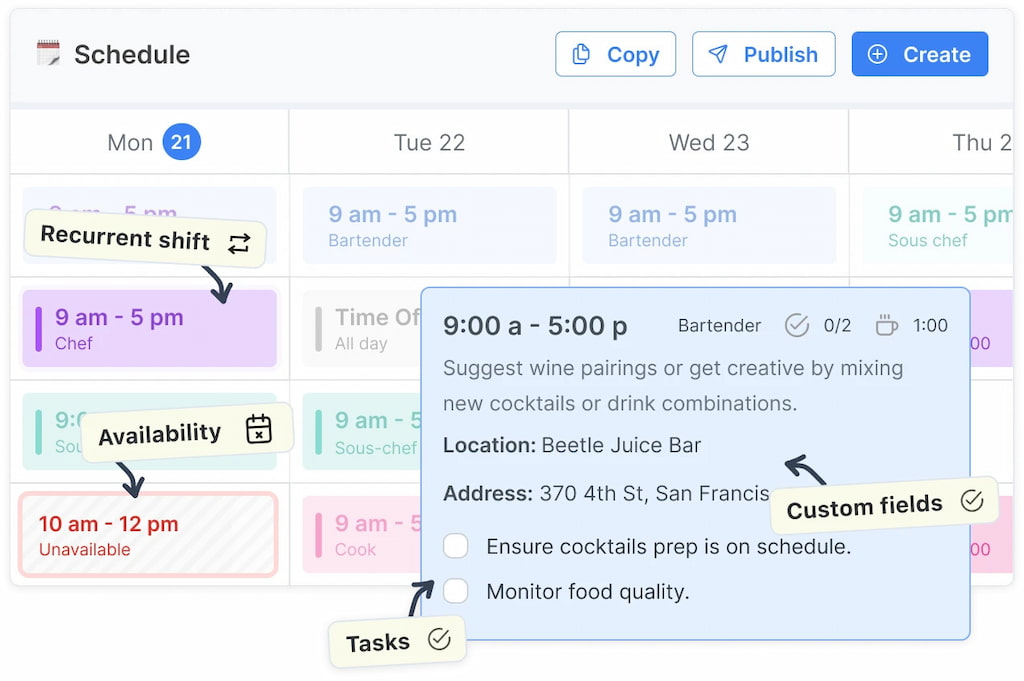Running a restaurant is never easy. Servers call in sick, kitchen staff swap shifts, and the dinner rush keeps coming. Without a clear schedule, coverage gaps and overtime can quickly become a problem. Making an effective restaurant employee schedule isn’t just about filling shifts—it’s about balancing coverage, staff preferences, and labor costs. Tools like Shifts by Everhour help by automating schedules, sending real-time updates, and giving staff mobile access. This guide will show you how to create a restaurant schedule that works, with tips and tools to make the process easier.
🍽️ Understanding Restaurant Scheduling
Managing a restaurant schedule isn’t just filling in shifts—it’s about having the right team in the right place at the right time.
📋 What a restaurant employee schedule entails
A solid schedule covers every role, from servers and bartenders to cooks and hosts. Key elements include:
- ⏰ Shift start and end times
- 🍽️ Breaks and meal periods
- 🎉 Special events or peak hours
- ✅ Employee availability and preferences
⚖️ The difference between good and bad scheduling
-
Good scheduling:
Ensures coverage during peak hours, balances workloads, and prevents last-minute conflicts. Happy staff, happy customers. -
Bad scheduling:
Leads to overworked employees, understaffed shifts, and frustrated diners. Often relies on guesswork or messy spreadsheets.
🎯 Goals of effective scheduling
- Coverage: Every shift has enough staff to run smoothly.
- Fairness: Evenly distribute shifts, weekends, and holidays.
- Efficiency: Optimize labor hours to control costs.
- Cost control: Minimize overtime while maintaining service quality.
![how to make a restaurant employee schedule that works every time [2025]](https://blog-cdn.everhour.com/blog/wp-content/uploads/2025/11/restaurant-happy-1-1.gif)
With these fundamentals, restaurant managers can create schedules that keep operations seamless and staff engaged.
⚠️ Core Challenges in Restaurant Scheduling
Restaurant scheduling is a constant balancing act. Managers face a variety of hurdles that can disrupt service if not handled carefully:
🚨 Handling last-minute absences and shift swaps
Employees calling in sick or requesting swaps can throw off your entire schedule. Real-time updates and flexible coverage plans are essential to avoid chaos.
💰 Avoiding overtime and managing labor costs
Overstaffed shifts drain your budget, while understaffed shifts hurt service quality. Effective scheduling keeps labor costs in check without sacrificing coverage.
⚖️ Balancing workloads to prevent burnout
Rotating shifts fairly between servers, cooks, and hosts prevents overwork and keeps morale high. Burned-out staff leads to mistakes and higher turnover.
🔄 Coordinating front-of-house and back-of-house teams
Smooth service requires both FOH and BOH teams to be aligned. Miscommunication between the kitchen and floor staff can create delays and unhappy customers.
✅ Proven Restaurant Scheduling Techniques
Keeping your restaurant running smoothly starts with the right scheduling approach. Here are the most effective techniques:
⏰ Fixed shifts
Fixed schedules provide stability and predictability for your team. Employees know their hours in advance, which reduces confusion and scheduling conflicts.
🔄 Rotating shifts
Share night, weekend, and holiday duties fairly among staff. Rotating shifts prevent burnout and keep morale high.
📊 Staggered shifts
Spread start and end times to avoid peak-hour congestion. This ensures smooth service during busy periods without overloading your team.
🤝 Flexible scheduling
Flexible schedules accommodate employee availability to improve retention. Giving staff input on their schedules helps balance personal needs with restaurant demands.
🔮 Predictive scheduling
Use historical sales and staffing data to forecast busy periods. Anticipating demand helps you schedule the right number of employees at the right time.
🛠️ Key Features to Look for in Scheduling Software
Choosing the right scheduling software can make or break your restaurant operations. Look for these essential features:
🗓️ Shift creation and automation
Quickly build, copy, and adjust schedules with minimal effort. Automation reduces errors and saves hours of manual work.
📲 Real-time notifications and shift swapping
Instantly alert staff about changes, and let them swap shifts directly through the app. Keep everyone informed and reduce miscommunication.
⏱️ Time tracking and payroll integration
Monitor hours worked, breaks, and overtime. Integration with payroll ensures accurate paychecks and easier cost management.
📱 Mobile access for staff on the go
Let employees check schedules, confirm shifts, and request time off from their phones—anytime, anywhere.
📊 Reporting and labor cost insights
Visualize staffing trends, labor costs, and schedule efficiency. Make informed decisions to optimize coverage and reduce unnecessary expenses.
🛎️ Best Restaurant Scheduling Tools
| Tool | Key Features | Pricing | Ideal For |
|---|---|---|---|
| Shifts by Everhour | Automated shift creation, real-time notifications, mobile access, reporting | Starts at $5/user/month | Small to medium restaurants, cafes, and multi-location chains |
| 7shifts | Shift scheduling, labor compliance, time tracking, employee messaging | Free basic plan; paid from $17.99/user/month | Restaurant teams of all sizes |
| Homebase | Scheduling, time tracking, team communication, payroll integration | Free plan available; paid from $14/month | Small restaurants and cafes |
| HotSchedules | Automated scheduling, labor forecasting, reporting, mobile access | Custom pricing | Mid-size to large restaurants |
| When I Work | Scheduling, time tracking, notifications, team chat | Free for small teams; paid from $2/user/month | Small to medium restaurant teams |
| Deputy | Shift planning, time tracking, labor compliance, mobile notifications | From $2/user/month | Restaurants with multiple locations |
| Shiftboard | Scheduling automation, compliance tracking, reporting, mobile alerts | Custom pricing | Mid-size to enterprise-level restaurants |
| ZoomShift | Shift planning, time tracking, notifications, reporting | From $2/user/month | Small to medium restaurants |
Tool highlights
- Shifts by Everhour: Great for flexible scheduling, real-time notifications, and reporting.
- 7shifts: Strong labor compliance and employee messaging features.
- Homebase: Excellent free option for small teams.
- HotSchedules: Ideal for larger operations needing advanced forecasting.
- When I Work: Simple scheduling and team communication for small restaurants.
- Deputy: Best for multi-location restaurants requiring compliance tracking.
- Shiftboard: Enterprise-level features with automation and reporting.
- ZoomShift: Affordable option with basic scheduling and time tracking.
🛎️ How Shifts by Everhour Helps Restaurants
Running a restaurant smoothly means having the right staff in the right place at the right time. Shifts by Everhour makes this effortless:
- 🗓️ Simplifies shift planning and coverage: Create, copy, and adjust schedules quickly without the headache of spreadsheets.

- ⚡ Sends real-time updates and reminders: Staff are instantly notified of shift changes, swaps, or coverage needs.
- ⏱️ Tracks attendance and labor hours: Monitor who clocked in, worked extra, or is approaching overtime limits.

- 💬 Improves transparency and communication: Team members can see their shifts, pick up open slots, and communicate without endless texts.
- 📝 Reduces administrative workload: Automate routine scheduling tasks so managers can focus on running the restaurant, not chasing schedules.
With Shifts by Everhour, restaurants can keep operations smooth, staff happy, and customers satisfied.
🗂️ How to Create an Effective Restaurant Schedule
Creating a schedule that works for both your team and your restaurant requires planning and flexibility:
- 👥 Assess staff availability and skills: Know who can work when and match shifts to experience or certifications.
- ⏰ Plan for peak hours and special events: Schedule extra coverage during lunch, dinner rushes, and special occasions.
- ⚙️ Use software to automate repetitive tasks: Let tools like Shifts by Everhour handle shift creation, swaps, and notifications.
- 🔄 Regularly review and adjust the schedule: Check attendance, overtime, and feedback to improve future schedules.
With these steps, you can create schedules that keep your restaurant running smoothly while keeping employees satisfied.
❓ FAQ
What is a restaurant employee schedule?
It’s a plan that assigns shifts to staff, ensuring all roles—front-of-house and back-of-house—are covered efficiently.
How far in advance should I create schedules?
Ideally 1–2 weeks ahead to allow staff to plan and reduce last-minute changes.
What is the best way to handle shift swaps?
Use scheduling software like Shifts by Everhour to let employees request swaps and ensure coverage without confusion.
How can I reduce labor costs while scheduling?
Plan shifts based on peak hours, track overtime, and avoid overstaffing with predictive scheduling tools.
Can scheduling software help prevent employee burnout?
Yes, features like fair shift distribution, workload balancing, and flexibility improve staff satisfaction.
Is mobile access important for restaurant scheduling?
Absolutely. Mobile access lets staff check shifts, swap shifts, and receive notifications anywhere.
What are the benefits of using software over spreadsheets?
Automation, real-time updates, reduced errors, better visibility, and easier compliance tracking.
Conclusion
Effective restaurant scheduling is about more than just filling shifts—it ensures coverage, controls labor costs, and keeps your team happy. Using smart tools like Shifts by Everhour makes creating, adjusting, and managing schedules faster and easier. With the right software, you can focus on running your restaurant smoothly while your staff stays informed, engaged, and ready to deliver great service.

